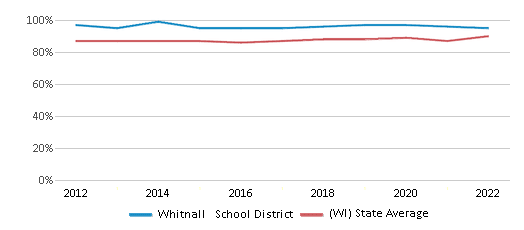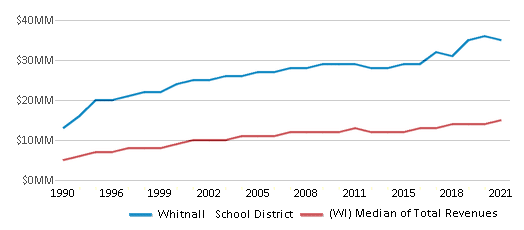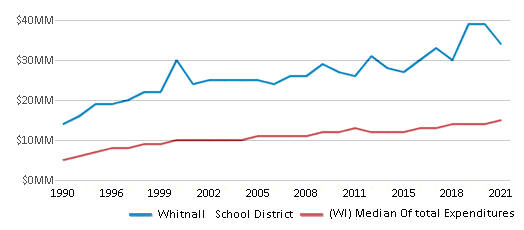Top Rankings
Whitnall School District ranks among the top 20% of public school district in Wisconsin for:
Category
Attribute
Reading/Language Arts Proficiency
Highest reading/language arts proficiency (Top 20%)
Graduation Rate
Highest graduation rate (Top 20%)
Diversity
Most diverse schools (Top 1%)
Community Size
Largest student body (number of students) (Top 1%)
For the 2025 school year, there is 1 public charter school serving 106 students in Whitnall School District.
Public Charter Schools in Whitnall School District have a diversity score of 0.44, which is less than the Wisconsin public charter school average of 0.70.
Minority enrollment is 26% of the student body (majority Hispanic), which is less than the Wisconsin public charter school average of 54% (majority Hispanic and Black).
Overview
This School District
This State (WI)
# Schools
5 Schools
235 Schools
# Students
2,394 Students
48,388 Students
# Teachers
168 Teachers
2,525 Teachers
Student : Teacher Ratio
14:1
14:1
District Rank
Whitnall School District, which is ranked within the top 30% of all 444 school districts in Wisconsin (based off of combined math and reading proficiency testing data) for the 2021-2022 school year.
The school district's graduation rate of 95% has stayed relatively flat over five school years.
Overall District Rank
#92 out of 450 school districts
(Top 30%)
(Top 30%)

Math Test Scores (% Proficient)
47%
39%

Reading/Language Arts Test Scores (% Proficient)
49%
38%

Science Test Scores (% Proficient)
54%
44%

Graduation Rate
≥95%
90%

Students by Ethnicity:
Diversity Score
0.51
0.70
# American Indian Students
3 Students
323 Students
% American Indian Students
n/a
1%
# Asian Students
104 Students
2,755 Students
% Asian Students
4%
6%
# Hispanic Students
432 Students
10,553 Students
% Hispanic Students
18%
22%
# Black Students
102 Students
9,860 Students
% Black Students
4%
20%
# White Students
1,613 Students
22,324 Students
% White Students
68%
46%
# Hawaiian Students
n/a
43 Students
% Hawaiian Students
n/a
n/a
# Two or more races Students
140 Students
2,520 Students
% of Two or more races Students
6%
5%
Students by Grade:
# Students in PK Grade:
111
2,497
# Students in K Grade:
144
3,179
# Students in 1st Grade:
129
3,214
# Students in 2nd Grade:
148
3,307
# Students in 3rd Grade:
153
3,254
# Students in 4th Grade:
148
3,294
# Students in 5th Grade:
158
3,128
# Students in 6th Grade:
182
3,465
# Students in 7th Grade:
188
3,542
# Students in 8th Grade:
199
3,680
# Students in 9th Grade:
212
3,479
# Students in 10th Grade:
204
3,746
# Students in 11th Grade:
203
4,051
# Students in 12th Grade:
215
4,552
# Ungraded Students:
-
-
District Revenue and Spending
The revenue/student of $14,818 in this school district is less than the state median of $17,039. The school district revenue/student has stayed relatively flat over four school years.
The school district's spending/student of $14,046 is less than the state median of $17,011. The school district spending/student has stayed relatively flat over four school years.
Total Revenue
$36 MM
$13,869 MM

Spending
$34 MM
$13,846 MM

Revenue / Student
$14,818
$17,039

Spending / Student
$14,046
$17,011

Best Whitnall School District Public Charter Schools (2025)
School
(Math and Reading Proficiency)
(Math and Reading Proficiency)
Location
Grades
Students
Rank: n/an/a
Core4
Charter School
5000 S 116th St
Milwaukee, WI 53228
(414) 525-8404
Milwaukee, WI 53228
(414) 525-8404
Grades: PK
| 106 students
Recent Articles

Year-Round Or Traditional Schedule?
Which is more appropriate for your child? A year-round attendance schedule or traditional schedule? We look at the pros and cons.

Why You Should Encourage Your Child to Join a Sports Team
Participating in team sports has a great many benefits for children, there is no doubt. In this article you will learn what those benefits are.

White Students are Now the Minority in U.S. 九游体育s
Increasing birth rates among immigrant families from Asia and Central and South America, combined with lower birth rates among white families, means that for the first time in history, public school students in the United States are majority-minority. This shift in demographics poses difficulties for schools as they work to accommodate children of varying language abilities and socio-economic backgrounds.





